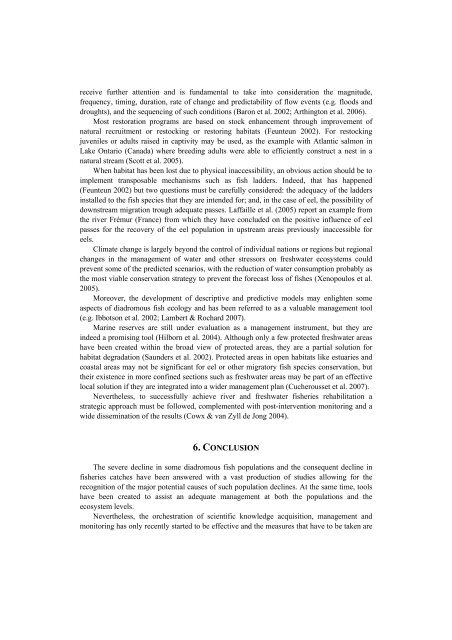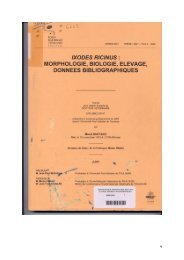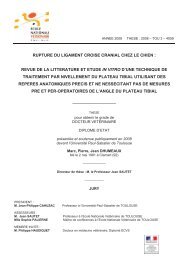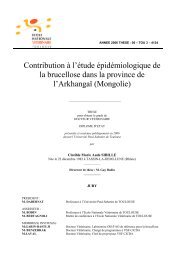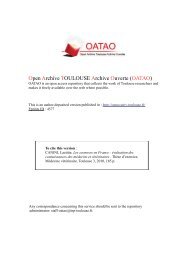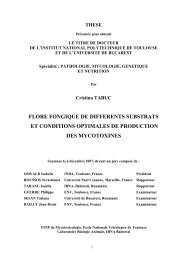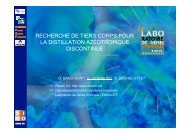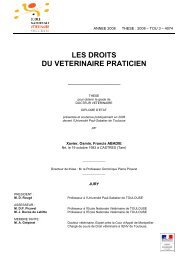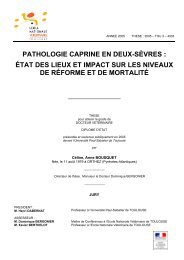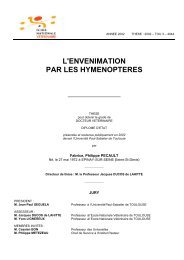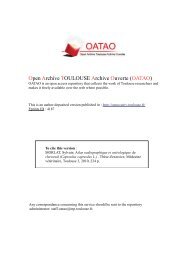PDF ( Author's version) - OATAO (Open Archive Toulouse Archive ...
PDF ( Author's version) - OATAO (Open Archive Toulouse Archive ...
PDF ( Author's version) - OATAO (Open Archive Toulouse Archive ...
Create successful ePaper yourself
Turn your PDF publications into a flip-book with our unique Google optimized e-Paper software.
eceive further attention and is fundamental to take into consideration the magnitude,<br />
frequency, timing, duration, rate of change and predictability of flow events (e.g. floods and<br />
droughts), and the sequencing of such conditions (Baron et al. 2002; Arthington et al. 2006).<br />
Most restoration programs are based on stock enhancement through improvement of<br />
natural recruitment or restocking or restoring habitats (Feunteun 2002). For restocking<br />
juveniles or adults raised in captivity may be used, as the example with Atlantic salmon in<br />
Lake Ontario (Canada) where breeding adults were able to efficiently construct a nest in a<br />
natural stream (Scott et al. 2005).<br />
When habitat has been lost due to physical inaccessibility, an obvious action should be to<br />
implement transposable mechanisms such as fish ladders. Indeed, that has happened<br />
(Feunteun 2002) but two questions must be carefully considered: the adequacy of the ladders<br />
installed to the fish species that they are intended for; and, in the case of eel, the possibility of<br />
downstream migration trough adequate passes. Laffaille et al. (2005) report an example from<br />
the river Frémur (France) from which they have concluded on the positive influence of eel<br />
passes for the recovery of the eel population in upstream areas previously inaccessible for<br />
eels.<br />
Climate change is largely beyond the control of individual nations or regions but regional<br />
changes in the management of water and other stressors on freshwater ecosystems could<br />
prevent some of the predicted scenarios, with the reduction of water consumption probably as<br />
the most viable conservation strategy to prevent the forecast loss of fishes (Xenopoulos et al.<br />
2005).<br />
Moreover, the development of descriptive and predictive models may enlighten some<br />
aspects of diadromous fish ecology and has been referred to as a valuable management tool<br />
(e.g. Ibbotson et al. 2002; Lambert & Rochard 2007).<br />
Marine reserves are still under evaluation as a management instrument, but they are<br />
indeed a promising tool (Hilborn et al. 2004). Although only a few protected freshwater areas<br />
have been created within the broad view of protected areas, they are a partial solution for<br />
habitat degradation (Saunders et al. 2002). Protected areas in open habitats like estuaries and<br />
coastal areas may not be significant for eel or other migratory fish species conservation, but<br />
their existence in more confined sections such as freshwater areas may be part of an effective<br />
local solution if they are integrated into a wider management plan (Cucherousset et al. 2007).<br />
Nevertheless, to successfully achieve river and freshwater fisheries rehabilitation a<br />
strategic approach must be followed, complemented with post-intervention monitoring and a<br />
wide dissemination of the results (Cowx & van Zyll de Jong 2004).<br />
6. CONCLUSION<br />
The severe decline in some diadromous fish populations and the consequent decline in<br />
fisheries catches have been answered with a vast production of studies allowing for the<br />
recognition of the major potential causes of such population declines. At the same time, tools<br />
have been created to assist an adequate management at both the populations and the<br />
ecosystem levels.<br />
Nevertheless, the orchestration of scientific knowledge acquisition, management and<br />
monitoring has only recently started to be effective and the measures that have to be taken are


